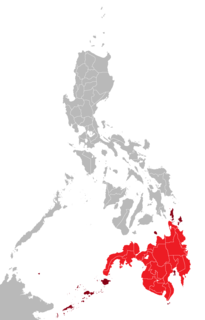
Mindanao is the second-largest island in the Philippines, after Luzon and seventh-most populous island in the world. Located in the southern region of the archipelago, the island is part of an island group of the same name that also includes its adjacent islands, notably the Sulu Archipelago. As of 2015 census, Mindanao has 25,700,000 inhabitants, while the entire island group has an estimated population of 27,021,036 as of 2021.

Zamboanga del Norte (Chavacano: Zamboanga del Norte; Cebuano: Amihanang Zamboanga; Subanon: Utara Sembwangan; Tagalog: Hilagang Zamboanga), officially the Province of Zamboanga del Norte, is a province in the Philippines situated within the Zamboanga Peninsula region in Mindanao. Its capital is Dipolog and the province borders Zamboanga del Sur and Zamboanga Sibugay to the south, Misamis Occidental to the east, and the Sulu Sea to the west.

Zamboanga del Sur, officially the Province of Zamboanga del Sur, is a province in the Philippines located in the Zamboanga Peninsula region in Mindanao. Its capital is the city of Pagadian. Statistically grouped with Zamboanga del Sur is the highly urbanized City of Zamboanga, which is geographically separated and a chartered city and governed independently from the province.
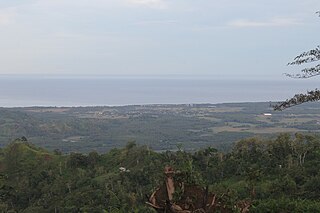
The Moro Gulf is the largest gulf in the Philippines. It is located off the coast of Mindanao Island, and is part of the Celebes Sea. The gulf is one of the country's tuna fishing grounds.

Zamboanga Peninsula is an administrative region in the Philippines, designated as Region IX. It consists of three provinces including four cities, and the highly urbanized Zamboanga City. The region was previously known as Western Mindanao before the signing of Executive Order No. 36 of 2001. The city of Zamboanga was designated as the regional center until Pagadian was designated as its new regional center, although Zamboanga City remains the region's cultural, economic, and educational center.

Zamboanga Sibugay, officially the Province of Zamboanga Sibugay, is a province in the Philippines located in the Zamboanga Peninsula region in Mindanao. Its capital is Ipil and it borders Zamboanga del Norte to the north, Zamboanga del Sur to the east and Zamboanga City to the southwest. To the south lies Sibuguey Bay in the Moro Gulf.
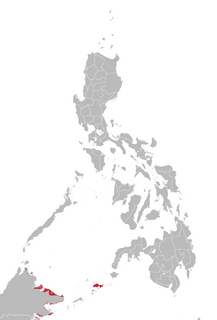
Tausug is an Austronesian language spoken in the province of Sulu in the Philippines and in the eastern area of the state of Sabah, Malaysia, by the Tausūg people. It is widely spoken in the Sulu Archipelago, the Zamboanga Peninsula, southern Palawan, and Malaysia.
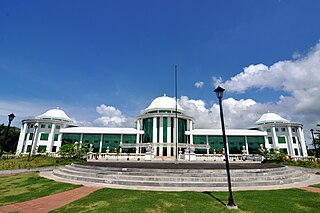
Dapitan, officially the City of Dapitan, is a 3rd class component city in the province of Zamboanga del Norte, Philippines. According to the 2020 census, it has a population of 85,202 people.

The Republic of Zamboanga was a short-lived revolutionary government, founded by General Vicente Alvarez with his Zamboangueño Revolutionary Forces after the Spanish government in Zamboanga, Philippines officially surrendered and turned over Real Fuerza de Nuestra Señora La Virgen del Pilar de Zaragoza to Gen. Vicente Álvarez in May 1899. On 28 May 1899, Gen. Vicente Álvarez proclaimed independence and became the first and last genuinely elected president of the republic.

The following outline is provided as an overview of and topical guide to the Philippines:

The Taluksangay Mosque was built by Hadji Abdullah Maas Nuno in 1885 in the Barangay Taluksangay, Zamboanga, the Philippines. It is the oldest mosque in Western Mindanao.

Zamboanga City, officially the City of Zamboanga, is a 1st class highly urbanized city in the Zamboanga Peninsula region of the Philippines. According to the 2020 census, it has a population of 977,234 people. It is the fifth-most populous and third-largest city by land area in the Philippines. It is the commercial and industrial center of the Zamboanga Peninsula Region.

These lists contain an overview of the government recognized cultural properties in the Philippines. The lists are based on the official lists provided by the National Commission for Culture and the Arts, National Historical Commission of the Philippines, and the National Museum of the Philippines.

The Dapitan Heritage Zone or Dapitan Historic Center is a declared historic district in Dapitan City, Zamboanga del Norte, Philippines. Because of its prehistoric origins, collection of heritage structures and role in the exile of local patriot Dr. Jose Rizal, the National Historical Commission of the Philippines declared a specific portion of the city, along with its heritage structures, as a Heritage Zone or Historic Center in 2011. The declaration was made in coordination with the 150th birth anniversary of Dr. Rizal in June 2011.

Selinog, historically known as Silino and also named Silinog, is an island barangay in Dapitan, Zamboanga del Norte, Philippines. It is coterminous with Silino Island and is located 12.9 kilometres (8.0 mi) off Tagolo Point, the northern entrance point to Dapitan Bay, and some 15 kilometres (9.3 mi) east of the island of Aliguay in the Bohol Sea. The island is a flat coralline island with a land area of 78 hectares. It is surrounded by 70 hectares of coral reefs and sandy areas. According to the 2010 census, the island community has a population of 712 inhabitants.
Elections will be held in Zamboanga Peninsula for seats in the House of Representatives of the Philippines on May 9, 2016.
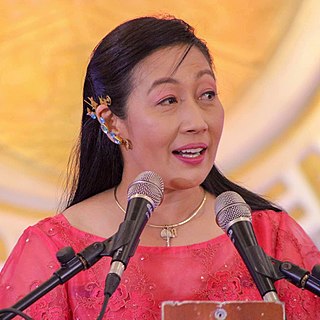
Local elections were held in Zamboanga City on May 13, 2019, within the Philippine general election. The voters elected for the elective local posts in the city: the mayor, vice mayor, and eight councilors per district.
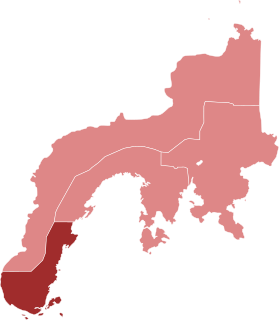
The COVID-19 pandemic in Zamboanga Peninsula is part of the worldwide pandemic of coronavirus disease 2019 caused by severe acute respiratory syndrome coronavirus 2. The virus reached Zamboanga Peninsula, Philippines on March 24, 2020, when the first case of the disease was confirmed in Zamboanga City. All provinces including the cities of Zamboanga and Isabela have recorded at least a single case.
























